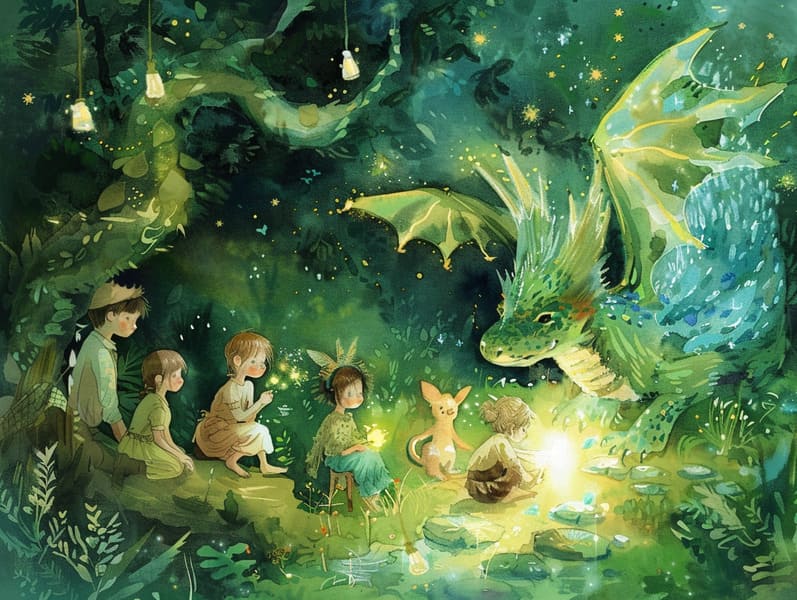The Evolution of Fairy Tales to Read and the Consistent Elegance.
The Evolution of Fairy Tales to Read and the Consistent Elegance.
Blog Article

Fairy tales have deep roots. These tales have been passed down from one generation to the next ages before they were ever published. They sprang from a variety of societies, including Middle Eastern traditions. They were initially passed along among older generations, often carrying themes and messages reflective of the societal norms and beliefs of the time.
The renowned Brothers Grimm, Jacob and Wilhelm (the Grimm brothers), were among the first to collect and release many of these beloved narratives. Their published works, "Grimm's Fables," included narratives like "The Story of Cinderella," "Little Brother and Little Sister," and "Snow-White and Rose-Red," which have since become pillars in the world of famous fairy tales. Similarly, H. C. Andersen's fanciful stories, such as "The Mermaid's Tale," and "The Ugly Duckling," have won hearts worldwide, establishing their place in the pantheon of treasured fairy tales.
Despite their historical roots, classic fairy tales remain as meaningful as ever, especially as children's night stories. These whimsical stories are now available in diverse formats, including richly illustrated books, fantastical animations, and web-based fairy tales.
Their lasting presence can be credited to several captivating elements:
Important Morals: Old fairy tales often whisper important moral lessons. Narratives like "The Tale of the Boy Who Cried Wolf" teach the importance of truthfulness, while "The Tale of the Tortoise and the Hare" underline the merits of resolve and modesty. These tales offer little ones clear distinctions between ethical and unethical, shaping their moral compass in a soft yet impactful way.
Empathy and Awareness: Traditional fairy tales frequently portray heroes facing problems and hurdles, encouraging readers to sympathize with their struggles and rally behind their triumphs. For instance, "The Story of Beauty and the Beast" conveys the virtue of seeing beyond looks to see the real character of a being, developing kindness and understanding.
Cultural Awareness: Many old fairy tales are deeply embedded in the cultural contexts from which they bloomed. Understanding these fairy tales can provide illuminating insights into different cultures, fostering a sense of international awareness and acknowledgment.
Inventiveness and Imagination: The extraordinary elements in classic fairy tales—talking animals—enliven children’s inventiveness. These narratives carry readers to enchanted realms, fostering innovative ideas and a sense of awe that endures a lifetime.
Old fairy tales are not only charming but also educational. They provide entrancing tools in fostering various thinking and feeling skills in children. When fairy tales are recited, they strengthen language acquisition by introducing new terms and detailed sentence structures. This practice also develops hearing perception and attention span, as young ones track the narrative, ready to see what happens next.
Furthermore, deliberating the themes and characters of traditional fairy tales can nurture problem-solving abilities and problem-solving abilities. Little ones are shown to see patterns, forecast, and get cause and effect. These examinations also help kids utter their thoughts and feelings, cultivating their emotional intelligence.
In today’s electronic age, the existence of digital fairy tales has made these narratives more attainable than ever. Websites and mobile apps supply wide arrays of old fairy tales that can be perused or listened on anytime, anywhere. Fairy tales recited are particularly sought after, extending an enjoyable way for young readers to experience these alluring stories. Spoken stories and read-out-loud stories transport characters and settings to life, often paired with mesmerizing music and harmonies that enhance the storytelling journey.
The unending appeal of ancient fairy tales lies in their ability to alter to today's society while keeping awesome site their central messages. Contemporary reimaginings of these narratives often integrate more varied characters and modern settings, making them familiar to today’s audience. However, the main ideas of guts, generosity, and lawfulness remain unchanged, continuing to connect with audiences of all ages.
Traditional fairy tales also offer a sense of ease and knowability. They extend a systematic narrative with a definite beginning, middle, and end, often wrapping up with the solving of conflicts and the triumph of virtue over vice. This consistency can be heartening for young readers, proffering a sense of steadfastness in an fluctuating world.
Classic fairy tales continue to captivate and guide new generations, maintaining their enchantment and relevance in modern society. As kids' bedtime tales, they distribute a perfect blend of captivation and insight, encouraging moral values, empathy, and creativity. The abundance of internet fairy tales and the widespread nature of fairy tales told out loud affirm that these old tales remain acquirable to new generations.
By protecting and relating these stories, we continue to honor the rich tapestry of myths and cultural heritage. Whether you are perusing a beautifully illustrated book, discovering a electronic library, or listening through an narrated book, the majesty of ancient fairy tales is always within reach. These tales point out of the enduring effect of stories and its ability to unite us across generations and cultures.
Be it you are seeing a gorgeously illustrated book, perusing a cyber library, or listening on an voice book, the captivation of old fairy tales is always within reach.
These stories highlight of the endless impact of fairy tales and its ability to bond us across eras and regions, forging a link that delights and instructs alike.